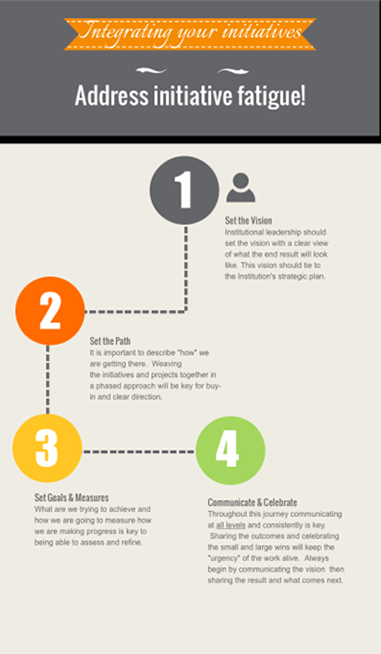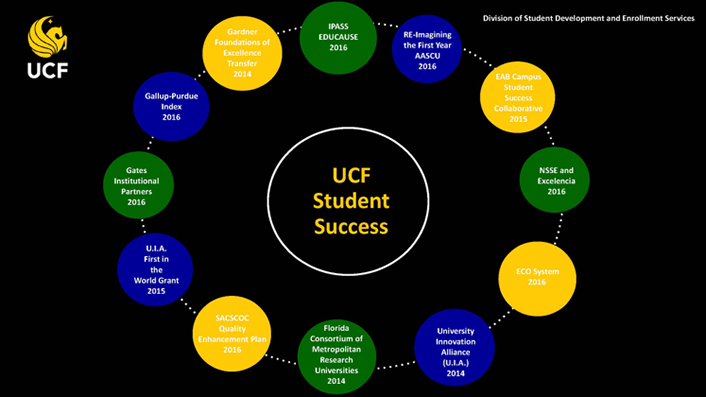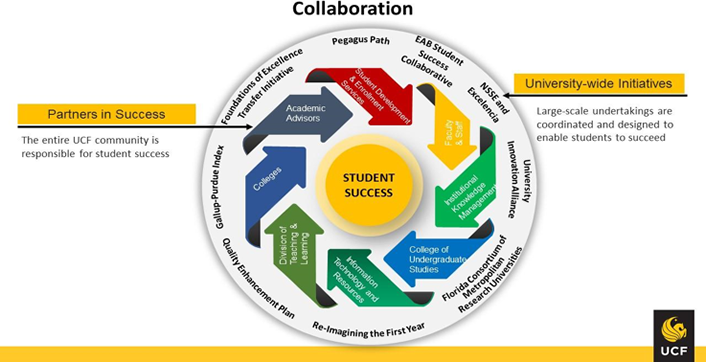
If you’ve ever worked in a college or university you’ve probably experienced this: someone announces that your institution will be rolling out the latest bright, shiny new tool or program to help more students succeed. Then, another initiative or project pops up, somewhere else on campus, with its own technologies, branding and stakeholders. And a few months later it happens again — a new effort that this time is even changing your role.
In our work with institutions that have received grants to implement comprehensive programs for technology-enhanced advising reform (Integrated Planning and Advising for Student Success, or iPASS), we see this a lot. And we’ve seen how these successions of disparate change initiatives, despite their worthy intentions, can burn out even the most committed staff and faculty.
It’s an issue we call “initiative fatigue.” Virtually everyone in higher education has an interest in improving the rates at which students gain degrees or credentials — but these interests, when not well coordinated, can lead to student confusion and staff disillusionment.
Moving forward on all projects successfully is a complex undertaking with the potential to dilute effort and sap staff morale, without providing intended benefits for the students and the institution. But instead of scaling back change efforts around student success — which are imperative today when completion rates remain alarmingly low, especially for students from disadvantaged groups — there are ways to get around and ultimately combat initiative fatigue.
Here are the essential steps we’ve seen our grantees applying:

- Set the vision. Institutional leaders must begin change initiatives by first providing a clear idea of what the college or university is striving for and what the end picture looks like.
- Set the path. How will the institution achieve the vision that has been established? This step calls on leadership to weave initiatives together strategically so that they are all part of the bigger, overarching vision that has been established.
- Set goals and measures. As part of determining whether you are on track to reach your vision or whether you need to change course or refine your efforts, initiative leaders will need to establish a clear, specific set of metrics and then collect data on them consistently. These metrics need to be tied to the different initiatives underway, making each one clearly contribute to the overarching vision.
- Communicate and celebrate. Communication across all levels of the institution with regular messages that restate the vision, the path, and the outcomes you are achieving is essential. Periodic updates, which should be tailored to the specific audience (e.g. students, faculty or staff), should also celebrate successes your institution achieves along the way. Good communication should address both head and heart!
With funding from the Bill & Melinda Gates Foundation and the Leona M. and Harry B. Helmsley Charitable Trust, EDUCAUSE awarded 26 colleges and universities iPASS grants of up to $225,000 in 2015. At several of those institutions, leaders have had notable success in following these steps, in part by developing their visions of how iPASS fits into the institutional landscape.
Northeast Wisconsin Technical College: Emphasizing Systems Thinking
At Northeast Wisconsin Technical College (NWTC), the iPASS work comprises the use of predictive analytics and risk targeting and interventions. It also includes an intake survey implemented this academic year.
According to John Grant, dean of student support services, communication is the key to making sure that important ongoing initiatives aren’t falling off the radar even as new initiatives launch. Grant notes, “One thing we’re working on and getting better at is looking at things through a system lens.”
NWTC staff have set up a “Dream Core Team,” with members from IT, student services, and human resources, to jointly develop and implement their vision and identify a path, as well as to define goals and measurements across different initiatives. The members of the core team recognize the need to help synthesize all the information they are gathering and help everyone involved make sense of it. This requires ongoing professional development to ensure that each person is prepared for their expected roles and changing responsibilities.
The core team has also placed a heavy emphasis on visualizing how those efforts align to help keep faculty and staff engaged. The graphic below is one example the core team has shared with other stakeholders on campus, portraying how different efforts fit together like a puzzle.

Training on the software is also important, Grant says, but educating faculty and staff on the new models for advising and student support that the technology enables is equally critical. To gain broad buy-in, he believes it is as necessary to educate stakeholders about the overall design for student success as it is to provide training on the specific tasks in which they are involved.
University of Central Florida: Revolving around Student Success
There’s a lot going on at UCF: rolling out the EAB Student Success Collaborative, the Foundations of Excellence transfer initiative, and participation in the Gallup-Purdue index, to name a few. As at NWTC, leaders at the University of Central Florida have made it a priority to link initiatives together and communicate to the community the ways in which these projects reinforce one another.
“All of our projects have the same goals and measures,” says Maribeth Ehasz, vice president of student development and enrollment services. When a project to reimagine the first-year experience launched this year, she made sure the measures and goals were the same for that as for projects already under way.
Two versions of the graphic that Ehasz and Elizabeth Dooley, vice provost for teaching and learning and dean of the college of undergraduate studies, developed and refined to conceptualize the initiatives moving forward at UCF clearly illustrate the way that their vision has developed. When UCF received its grant in fall 2015, iPASS joined a number of other student success initiatives being implemented, many involving external partners. In fact, Dooley notes, it was the iPASS grant that gave them the idea of pooling major initiatives and organizing them around an overarching concept: student success.

The first version of the graphic that Ehasz developed (above) depicted these initiatives as planets orbiting the “sun” of student success. Over the past year, their thinking has evolved, to incorporate not only external relationships but also the departments and staff engaged within UCF itself. Student success remains the radiant orb around which everything revolves. For Ehasz, Dooley, and their teams, these graphical representations are tools to help others at the institution see and understand how the initiatives relate to each other.

This year, Dooley and Ehaz have gone a step farther, syncing up initiatives by consolidating some previously separate meetings so that as new initiatives come up, everyone involved is able to look together at how those new initiatives will fit into what they are already doing. They have used the illustrations to spread the theme: that all involved faculty and staff are contributors toward the achievement of student success.
Change doesn’t stop. So what happens when an institution achieves its goal and reaches its targets for an initiative? It will be time to begin the next one: to set the next vision, next path, new goals and measures — and to incorporate it into the ongoing circle of continuous institutional evolution and transformation.
This post first appeared on EdSurge on May 13, 2017.
Ana Borray is the director of iPASS implementation services at EDUCAUSE. Follow her on Twitter @ABorray.
Nancy Millichap is a program officer with the EDUCAUSE initiative Next Generation Learning Challenges (NGLC), which makes grants aimed at dramatically increasing college readiness and completion through applied technology.
